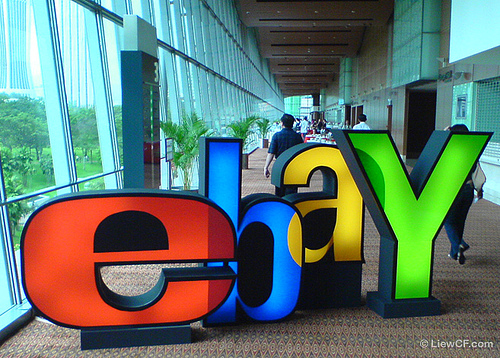
OVERVIEW
In 1995 eBay Inc. was founded in
HISTORICAL CONTEXT
The San Jose–based eBay was created to capitalize on the increasing expansion of the Internet into everyday life in the
As the Internet became more popular, eBay was able to expand quickly, and the company set up companion sites around the world. Soon eBay began describing itself as ‘‘The World’s Online Marketplace.’’ The company’s profits came via fees it collected on each transaction as well as from advertising it sold on its assorted websites. The approach was largely successful, and in 2003 alone more than 900 million items were listed on eBay. By 2004 eBay was offering the PayPal service, which enabled buyers to pay sellers through their credit cards or via secure account transfers. There were several subsections to the eBay site, including one for automobile sales, labeled ‘‘eBay Motors.’’ Consumers could search cars by make and model or by price. Because higher-priced items generated higher fees, the company made more money from automobile sales than it did from many other items sold via www.ebay.com.
At the outset eBay relied on word of mouth to promote its business. As the company became more successful, it branched out into print and radio advertising. In 2002 eBay conducted its first television campaign, ‘‘Do It eBay,’’ which was developed by Goodby, Silverstein & Partners. The San Francisco–based agency had been responsible for all of the company’s radio advertising through 2004 as well. Goodby, Silverstein & Partners was best known for its award-winning ‘‘Got Milk’’ campaign on behalf of the California Milk Processor Board. The agency was founded in 1983 by Jeff Goodby and Rich Silverstein, who had previously worked together at the Ogilvy & Mather agency.
TARGET MARKET
EBay usually aimed for a very large target market. The company wanted to be the destination of choice for anyone shopping online. The website had always been especially popular with collectors, who used the site to track down rare and hard-to-find items, such as out-ofprint records or idiosyncratic household goods. The site listed many types of items for sale, however, and it was also a major attraction for bargain shoppers and consumers who were comfortable doing their shopping online. The company also allowed people to sell automobiles on the site. These were expensive items, which meant that the company collected higher fees on such transactions. The kind of shopper that bought an automobile on eBay was a typical used-car shopper: younger and on a budget. The company saw automobile sales as a prime candidate for growth.
COMPETITION
The most serious competitor for eBay, especially for bigticket items such as automobiles, was the search engine Google. Like eBay, Google did not sell anything itself. Instead, consumers used Google’s website to search for items online. For example, a used-car dealer or an individual would post on a website the vehicles they had for sale, and buyers would find the site via Google. Other search engines, such as Yahoo!, offered similar services. In fact, Yahoo! even allowed sellers to post ads that would appear in the Yahoo! Autos section of the search engine’s website, www.yahoo.com. Although neither of these companies provided online auction services, they competed with eBay by providing an alternative way for consumers to buy automobiles online. The company was even more concerned, however, about its off-line competitors. While certain products, such as music files, collectibles, or books, seemed to attract online buyers easily, most consumers were accustomed to buying automobiles through off-line means, such as classified advertisements in newspapers. To grow its automobileselling business eBay needed to lure more of these people into buying (and selling) automobiles on ebay.com.
MARKETING STRATEGY
Goodby, Silverstein & Partners was the agency of record on the 2004 radio campaign, which consisted of a 60-second spot titled ‘‘Abbreviated.’’ It was part of the $250 million in
The commercial also touted eBay’s Vehicle Protection Program, which guarded consumers against being stuck paying for a car that was not in as good a condition as the advertisement had claimed. Finally it reminded listeners that eBay offered a nationwide customer base, as opposed to the local reach of most newspapers. Even when describing eBay’s own services, the narrator still slipped into abbreviated words occasionally, using them sporadically enough that his meaning was not lost but often enough to keep the spot’s humor going. ‘‘Abbreviated’’ referred specifically to ‘‘eBay Motors’’ instead of just ‘‘eBay’’—even though ‘‘eBay Motors’’ was only a category on www.ebay.com, as opposed to an actual separate entity. This distinction was made for consumers who were used to thinking about eBay as a place to buy smaller items, such as household goods or clothing. It also reinforced the idea that eBay was not only a place where automobiles were available for sale but also a natural place to go shopping for these kinds of items. This subtle gesture allowed the spot to concentrate on the benefits of selling cars on eBay without having to clear any hurdle the listener might have about shopping for an automobile that way. The commercial was recorded at the GSP Post studio in
OUTCOME
The spot was a success, although it also marked the end of eBay’s account with Goodby, Silverstein & Partners. In March 2005 eBay ended its relationship with the agency, replacing it with the New York–based BBDO. The company believed that BBDO, a larger agency, was better equipped to provide integrated marketing campaigns that would combine Internet, television, print, and radio elements.
Regardless, ‘‘Abbreviated’’ was particularly successful with critics. It received a Silver Lion in the Radio category at the 2005 International Advertising Festival in


No comments:
Post a Comment